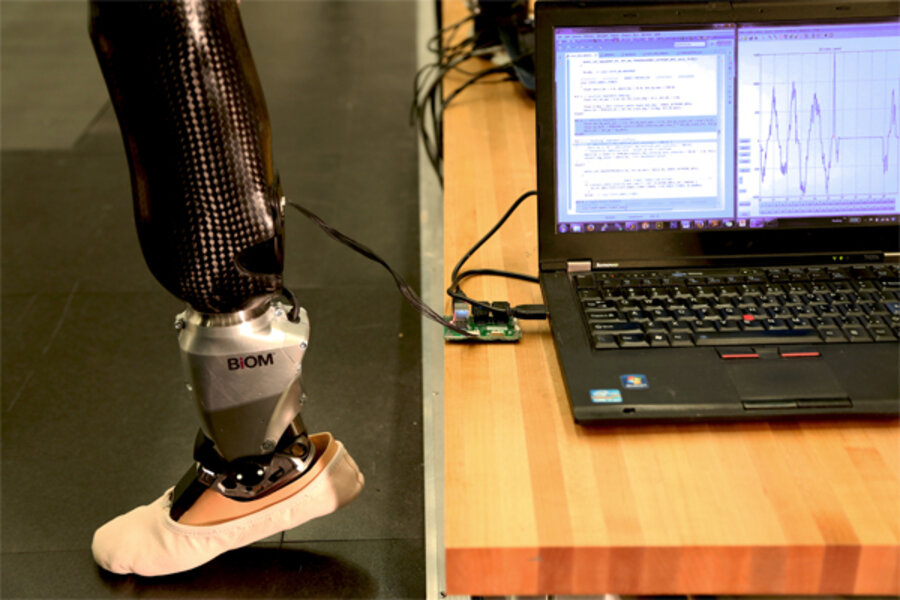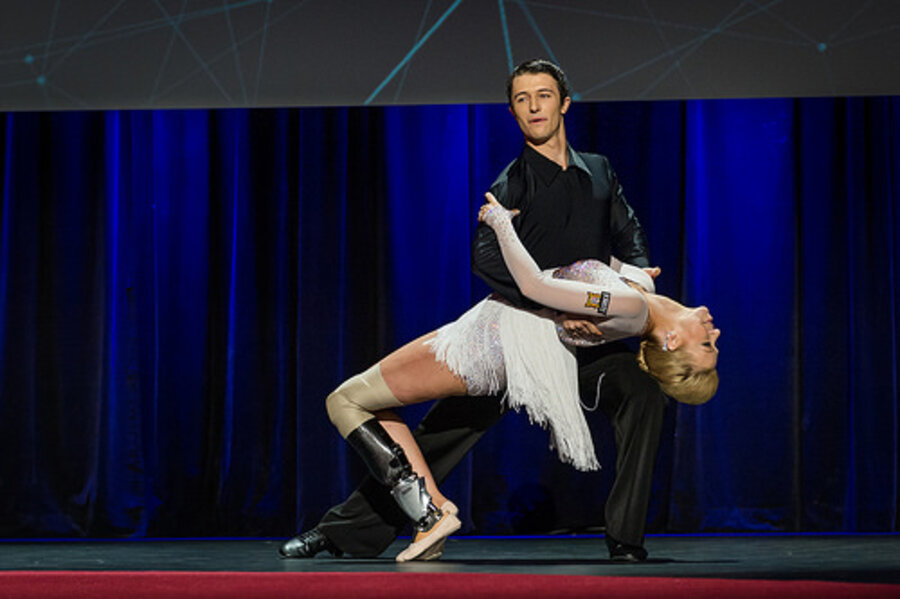Back on the dance floor: Boston Marathon victim inspires prosthetics innovation
Loading...
| Cambridge, Mass.
While thousands ran the 2014 Boston Marathon on Monday, the story of one 2013 marathon bombing victim spurred a prosthetics innovation that will help amputees for years to come.
Adrianne Haslet-Davis was a ballroom dance teacher before one of the blasts at the finish line destroyed her left leg from the knee down. While recovering at Boston’s Spaulding Rehabilitation Hospital she attended a lecture by Hugh Herr, director of the Biomechantronics group at the MIT Media Lab and a double leg amputee himself. After the lecture, Mr. Herr and Ms. Haslet-Davis connected, and Herr took on the challenge to get her back in dancing shoes. A little over 200 days after the Boston Marathon bombings, Haslet-Davis was able to dance the rhumba thanks to a specially developed bionic limb.
“We’re beginning this age where machines are going to fundamentally change human ability, physically and cognitively,” says Herr at a recent press conference.
Ask any amputee and they will tell you wearing most prosthetic limbs are no walk in the park. Many prosthetic limbs are heavy, passive (movement originates from residual limbs), and uncomfortable (due to stiff materials). Herr himself realized this when he lost both his legs below the knees to frostbite after a mountain climbing accident, and decided to dedicate his life to creating a better limb for amputees.
A bionic limb differs from a normal prosthetic in that it isn’t passive—it has a series of motors, springs, and algorithm-running microprocessors which propel the limb forward based on where a limb is in stride. It's all inspired by the body’s muscle-tendon structure and movement ("We steal from nature" says Herr). This creates a more natural gait, lessens the likelihood of osteoarthritis, and uses less energy to walk.
Herr and his team commercialized this type of prosthetic through BiOM, an MIT Media Lab spin-off company, and since 2010 the company has outfitted more than 900 amputees, including 400 wounded US soldiers, with the BiOM walking prosthesis.
This being said, dancing is far different from walking. When someone dances the rhumba, movement isn’t just up and down: it is left and right, twirling, and constantly changing. Due to this complexity, it hasn’t been looked at much in the prosthetics research community. But Herr stepped up. “I really understood Adrianne’s passion for dance and her desire to get back to the dance floor,” he says in reference to his own passion for rock climbing that he thought would be impossible to return to after his own amputation.
“I think after the attack all of us wanted to do something,” he says. “I realized our unique position, the fact that this lab is in the Boston area and the fact that we specialize in limb bionics…we’ve dedicated our resources to help out.”
In order to measure this unique movement, the research team brought in a local ballroom dancer, who was about Haslet-Davis’s size and skill level, to dance on what looks like a high-tech catwalk. The dancer had over 60 retro-reflective markers on her body. Cameras lining the wall of the lab followed her movements. Scales in the platform where she danced measured how the dancer interacted with the ground. This allowed researchers to track the angles of joint movements and measure the subtle interactions between body, foot, leg, and the ground, and create a description of the torques that dictate a dancer’s movement.
So how does this translate to movement when connected to an amputated limb?
“You can think of the dancer’s biological body and their artificial limb as a dance partnership,” says Herr. “The dancer is the lead of the dance and the bionic limb is the follower of the dance.”
At a recent Ted Talk by Herr about the bionic limb, Haslet-Davis demoed her dance ability and wiped tears from her eyes after a short, but smooth, rhumba combination that included spins, dips, and quick steps. The limb can also dance the waltz and cha-cha.
“I’m thrilled to have danced again," she says about the performance in a statement. “I was always determined to dance again, and I knew that I had to, that I would, and here I am. My first dance happening to be so near the anniversary of the marathon bombing stands as a reminder that I’m a survivor, not a victim.”
Though dancers have notoriously high pain tolerance levels, ensuring a comfortable limb has also been key to the researcher’s efforts. Many researchers have experimented with 3D printers to improve the price point and replicability of prosthetic limbs. Herr’s team on the other hand, is using 3D printers to print sockets in multiple materials that custom fit to each amputee.
“[The 3D printer] prints a prosthetic socket where the soft parts meet up against the hard parts of a person’s residual limb and the hard parts meet up with the soft parts,” says Dr. Elliot Rouse, the lead researcher on the bionic dance limb project, in an interview with the Monitor. “What that does is create a much lower stress on the person’s residual limbs, which reduces pressure sores and discomfort.”
While Haslet-Davis may be able to dance, and Herr has customized limbs that enabled him to return to climbing, neither would be able to run a marathon on their bionic prosthetics – yet. Herr says the technology enables users to navigate short distances quickly but doesn’t yet support the stamina needed for long distances. There are prosthetics that work in that way, which use carbon springs to store and release energy (which is what you would see when you see amputees running short and long-distance races). The most famous example is South African Oscar Pistorius, aka "The Blade Runner."
The price is also still prohibitive: each prosthetic costs around $40,000 and isn't covered by Medicare or Medicaid. Most of the US soldier's BiOM's limbs have been paid for by the Veterans Administration and Department of Defense, and a few others have been paid by private insurers. Herr is advocating for coverage to be extended more widely in the near future.
The next challenge for Herr is launching the Center for Extreme Bionics at MIT along with fellow researcher Edward Boyden, which aims to bring synthetic neurobiology, biomechatronics, and biomaterials together to work on repairing the body. Ultimately Herr wants to connect bionic limbs to the brain (“the ultimate supercomputer” as he calls it) and add sensory technology to the limb in order to transmit stimulation back to the brain. In other words, he hopes one day people will be able to feel through a prosthetic limb.
In the meantime, Herr and running activist Mary Kelly Persyn, have created No Barriers Boston, a fund to help those who lost limbs in the Boston Marathon bombings receive sport-specific prosthetic limbs.
Ultimately he hopes “we can really advance technologies that will give us a vision of the future where disability is no more,” he says.







